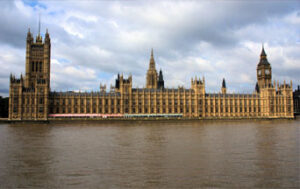
In the good times when people had faith, churches were the most beautiful and elevated buildings in cities. Churches provided an environment conducive to prayer when people raised their minds to God.
One example among thousands is how religious architecture marked Catholicism in nineteenth-century England when Catholics were a minority.
During the early centuries of Christianity and especially the Middle Ages, the Catholic faith and architecture flourished in Britain to the point that it earned the epithet, “Island of Saints.”
In the sixteenth century, however, the lurid King Henry VIII broke with the true Church to marry Anne Boleyn. He issued the “Act of Supremacy,” declaring himself the “new and supreme head of the Church in England.” This proclamation gave rise to the Anglican Church.
As a result, the Catholic religion was banned and persecuted for almost two centuries. A 1701 decree forbade any “papist” to rise to the English throne. Even after the Kingdom of Great Britain was established in 1707, Catholics were still excluded from voting, running for Parliament or exercising some professions.
Help Remove Jesus Bath Mat on Amazon
In 1778, this situation was mitigated with the so-called Papist Acts, which allowed Catholics to own private property, inherit land and serve in the army. These concessions enraged many Anglicans, which revealed how deep anti-Catholic sentiment ran in the country.
However, events outside the country changed this sentiment. During the French Revolution, thousands of French Catholic refugees settled in Britain. During the Napoleonic wars, Britain was allied with Catholic nations, especially Spain, Portugal and the Holy See.
These developments gave new courage to the children of the true Church. In 1829, Parliament passed the Emancipation Act, which granted Catholics civil rights almost equal to those of Protestants. Catholics could vote and hold public office.
Although officially unrecognized, the Catholic Church already had a considerable number of faithful at the time of the Emancipation Act. Around 50,000 members came from traditional Catholic families called “refusers.” A large influx of Irish Catholic immigrants later fled the Great Irish Potato Famine of 1845-49. The number increased from 224,000 Catholics in 1841 to 419,000 in 1851.
A third group of converts from the Anglican Church joined those two groups. These Catholics belonged to the Oxford Movement, which included French immigrants and the future Cardinals Newman and Manning, second archbishop of Westminster.
Satanic Christ Porn-blasphemy at Walmart — Sign Petition
In the Middle Ages, England constructed magnificent Gothic cathedrals, which still stand today as witnesses to the faith of those true Catholics. After the Act of 1829, there was a major revival of Catholic architecture.
One exponential Catholic architect was Augustus Pugin (1812-1852). His short and dynamic life transformed how English Catholics and Anglicans viewed ecclesiastical architecture. He inherited his father’s skills of draftsman, decorator and art critic, becoming a pioneer of the neo-Gothic style in England.
His father was a Frenchman who fled the French Revolution and married a Protestant wife. She took little August to attend religious services at the Scottish Presbyterian church.
The boy never felt at ease and always expressed displeasure at the Scottish church’s cold and sterile forms. As soon as he felt free from the obstacles imposed by his mother, he ran into the arms of the Catholic Church, which attracted his imaginative mind with its pompous ceremonies.
At age 23, Pugin converted to the Catholic Church. He wrote to a friend: “I can assure you that, after a closer and more impartial investigation, I am convinced that the Roman Catholic Church is the only true one and the only one in which the grand and sublime [Gothic] style of ecclesiastical architecture can be restored.”
In 1836, Pugin published his book Contrasts, in which he defended medieval architecture’s “wonderful superiority” over modern architecture. In this polemical book, he advocated a revival of medieval Gothic style and “a return to the faith and social structures of the Middle Ages.”
In 1839, he built his first Gothic church, St. Mary’s, for the 16th Earl of Shrewsbury, in Derby. He then constructed or designed many works, including four cathedrals. His designs can be seen in England, Ireland and even Australia.
This Catholic convert established himself as a decorator genius, always based on Gothic art. Westminster Palace, which houses the British Parliament and its iconic Big Ben clocktower, is his culminating work in this field and is still admired worldwide.
In 1840, this renowned Catholic architect built his favorite church, Saint Giles Cheadle. He said it was “the first really good thing I did.” The indefatigable August Pugin died prematurely on September 14, 1852, at just 40 years of age, leaving several disciples.
How Panera’s Socialist Bread Ruined Company
Over one hundred years later in the nineteen-fifties, church builders chose to design brutally modern churches influenced by the emerging liturgical movement. Both Liverpool Cathedral and the Church of Our Lady of Fatima in Harlow were pre-Vatican II projects built with a circular shape.
The modernist mentality fostered by the Council gave a tremendous boost to the so-called liturgical reforms. Thus, many Catholic architects started to build churches according to the new ideas. Consequently, those buildings lost their ability to attract even Catholics over time.
With the drastic decrease in the number of faithful, the construction of new churches in England practically stopped after 1975. The only contemporary Catholic architect catering to church design is Anthony Delarue, who dedicates himself to restoring churches vandalized by modern priests in the Council’s wake.
Today, empty churches reflecting the widespread flight of the faithful. Thus, England, like everywhere else, is unlikely to see new church construction soon. A Catholic architecture tradition of more than 200 years has come to a drastic end. May Our Lady have mercy on Holy Church.


